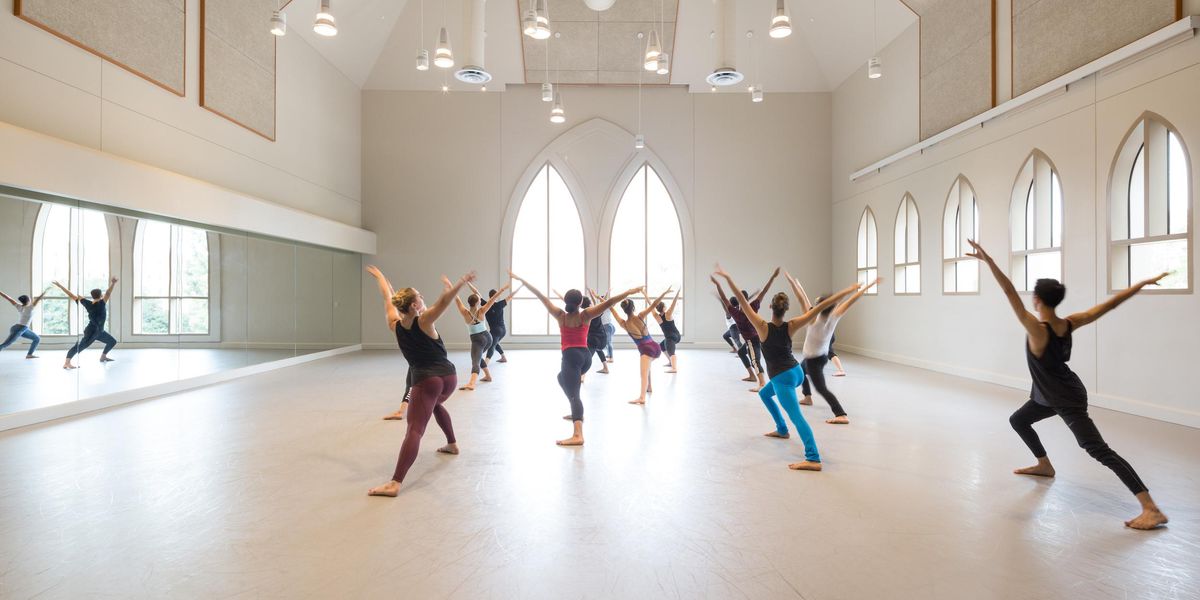Technique My Way: Katherine Fisher
Improving stamina in body and mind
In a rehearsal for Einstein on the Beach in Brooklyn, New York, Katherine Fisher, a sprightly and exacting dancer, crisply moves through Lucinda Childs’ Field Dance 2. At 5′ 3″, her cropped, shockingly blonde hair tousled and dripping with sweat, she jumps, pivots, turns, and battements, in lockstep with the rest of the cast, performing Childs’ calf-burning choreography with precision. The rhythmic complexity certainly befits a work honoring one of the world’s greatest physicists.
A versatile dancer, Fisher, 32, has worked for Childs for the last five years. Prior to this, she danced for companies including MOMIX, ODC/Dance, and Jennifer Muller/The Works. In a piece written about a performance of her own work, critic Gus Solomons jr wrote, “She has eye-catching dynamic attack, lightning-quick direction changes, and fully extended lines.” Solomons described her as possessing a “sparkling presence.” Even in rehearsal, these qualities shine through. Dance Magazine caught up with Fisher to talk about how she conditions both her mind and body for performance.
Keeping up with Einstein
Einstein on the Beach
, the groundbreaking 1976 opera directed by Robert Wilson and composed by Philip Glass (the original choreography by Andy DeGroat has been replaced by Childs’) is a type of work few dancers will experience. The 2012 revival of the production will land at the Brooklyn Academy of Music this month as part of an international tour. With a running time of five hours and intense, repetitive dance sections throughout, Einstein requires Fisher to be “on” the entire time.
Because it’s much longer than a typical performance and the likelihood for injury is high, physical therapists work with the dancers backstage during the show. Fisher also spends about an hour a day on a foam roller before company class, massaging knots, stiffness, and tension from tired, sore muscles.
After she was cast in Einstein, Fisher did something she’d been considering for a while—a 12-day Vipasana meditation retreat. Ten of those days were spent in complete silence; aside from walking (and a few stolen moments for downward-facing dogs) there was no movement component. “I spent hours processing emotional and physical pain, gaining awareness that things are temporary and passing,” says Fisher. The experience taught her to listen more attentively to her body, which has proved useful in a touring schedule that entails a pre-show class, one hour of hair and makeup, and finally five hours on- and offstage. “Performing this work requires great reserves of mental concentration,” says Fisher. “It is exceedingly challenging in terms of duration and stamina. I’m glad I took the initiative to make space for this mental training.”
Carving Out Time and Space
The first thing Fisher does each morning is to write in a journal, a ritual she began after reading Julia Cameron’s The Artist’s Way many years ago. “My ‘morning pages’ help to clear out the creative cobwebs and repetitive thoughts that can clutter the brain,” she shares. “I’m also sensitive to big groups, and when the company is on tour and we’re together all of the time, it can be overwhelming.” Writing things out, Fisher says, lends both the opportunity for clearer perspective and a haven from social interruptions. She has found that tangible objects like a notebook, foam roller, or yoga mat can be more than just tools for self-care; they’re also good places to go when you have limited personal time and need a break.
Body-centered Practice
In 2006, Fisher had knee surgery. She went back to dancing three weeks after—“far too soon,” she laments. A big part of her personal practice now is paying attention to pain or soreness in her body—not just trying to cover it up or block it out. “I used to use anti-inflammatories before and after performance. I rarely felt the real status of my body. I see so many dancers popping Advil like Chiclets—and it worries me. I still use anti-inflammatories when necessary, but with caution. I want to feel what’s happening onstage.”
This more mindful approach took root when Fisher was dancing for ODC. Post-surgery, after a period of reevaluation, she began expanding her practice beyond yoga, the gym, and dance training. “Gyrotonics saved my knee,” she says. “Private sessions with trainer Jen Hammer, when I’m home in New York, truly keep me going.” Fisher is rarely home, but when not on tour with Childs, she spends time producing her own work, which includes several dance films. She has also choreographed music videos for Canum Entertainment, an international production company.
Travel is hard on the body, and Fisher has a few simple, often overlooked remedies: sleep (at least eight hours a night), probiotics for the digestive tract (see “Your Body,” Aug.), eating whenever she’s hungry and not cutting calories during a production, sugar and alcohol in moderation, and tons of water. “It’s easy to be hard on ourselves as dancers,” Fisher says. “Adopting a practice of kindness to my body has gotten me farther than constant self-criticism.”
Jennifer Edwards writes for
The Huffington Post and is the author of the home/body app.
At top: In rehearsal for
Einstein on the Beach. Photo by Pavel Antonov, Courtesy Blake Zidell & Associates.
Easing Into It
As part of her warm-up, Fisher enjoys this “Eastern calisthenics” exercise, taken from the Chinese martial art Baguazhang:
• Stand in a parallel second position, your feet hip-distance apart, knees soft.
• Allow your arms to hang by your sides, relaxed and loose.
• Keeping your hips static, gently twist your upper body to the left, allowing your arms to follow and wrap lightly around your torso.
• Unwind and twist to the right. Continue this rotating side to side, gently warming up the spine, and keeping your core engaged yet relaxed.




